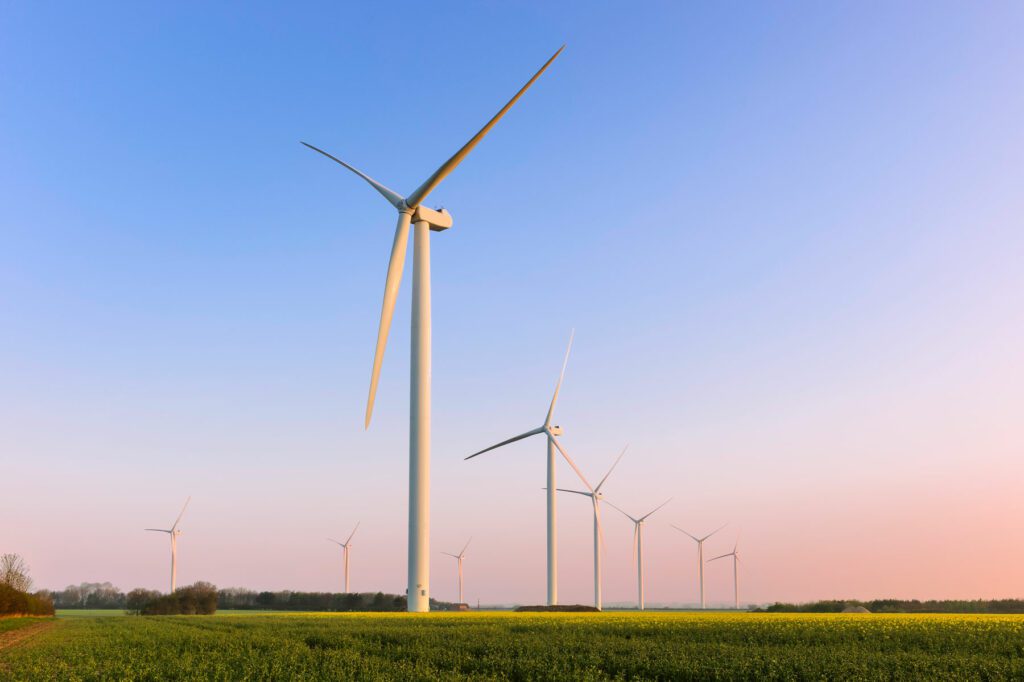Whilst some may liken them to something out of a H.G. Wells book, others will welcome the Labour government’s abolition of the moratorium on wind. But just how effective will the policy be? We took a dive into the new proposed regime and discussed some of the constraints the new government will need to overcome to achieve their decarbonised vision.
Firstly, however, a brief history. According to the national grid, wind turbines have been around a lot longer than many of us would expect. The first commercial wind turbine was created in the 1850s by inventor Daniel Halladay and businessman John Burnham in Illinois. They patented the first commercially viable windmill, the Halladay Windmill. In the UK, the first windmill for electricity generation was built in 1887 by James Blythe in Glasgow, Scotland. Whilst many in England may think that Scotland has always been at the cutting edge of innovation when it comes to wind turbines, I am sure few of us knew that they were capitalising on the technology before any of us were born!
It wasn’t until the late 1970s that the technology began to develop at scale. Catalysed by the US energy crisis of the 1970s, officials launched a research program backed by NASA to find a utility scale energy resource. Fast forward 20 years and the UK saw its first commercial wind farm developed in Delabole in 1991, consisting of 10 turbines. Momentum gathered at a slow pace but gradually grew, and the introduction of Government subsidy schemes in the early 2000’s saw an explosion of growth in this infant industry. By 2010 the UK’s total wind capacity was at 5.4 GW and in a continual trend of exponential growth the following 10 years saw the capacity quadruple to 24GW. However, although the industry was growing, expansion of onshore wind sites began to stall in 2015 and actually suffered a small decline in 2016, slowly regaining momentum thereafter, albeit at a slower growth rate.
So, what changed? In 2015, on the cusp of a general election, the incumbent Conservative Government announced their intention to withdraw subsidy support for onshore wind farms, in an effort to ‘halt the spread of onshore wind farms’. The motive for this move was twofold; the first constituting an alleged disdain from local communities towards wind farms and the second a perception that the country had enough onshore wind capacity to meet its then 2020 EU targets. The Conservatives were re-elected in 2015 and implemented their manifesto pledge by introducing a two-stage local authority test as new planning guidance.
The guidance stated that if a council wants to grant permission for a wind farm which involved more than one turbine it must be:
- Sited in areas identified as suitable for wind energy in the local or neighbourhood plan; and
- Granted only where planning impacts identified by communities had been fully addressed.
As councils had not identified suitable areas prior to this guidance, this effectively created a policy vacuum, stalling any plans for imminently prospective sites.
This policy remained unaltered until 2023, when a successive Conservative Government, led by Rishi Sunak, took small steps to ease the moratorium, amending the planning rules to make it easier for onshore wind farms to be built. In a seemingly token effort, the rules were amended to give sites the green light where there was “broad public support”. The act didn’t abolish the two-part test, but merely amended the second part by adding the words ‘and the proposal has community support’. The effort to ease the restrictions seemed to have achieved the contrary, by adding a sub element to the second part of the test, adding a third hurdle to overcome.
The 4 July marked the ascension of a new party into government. The Labour Party took the keys to number 10 and wasted little time in abolishing the moratorium on onshore wind. In a policy statement issued on Monday the 8 of July, the Treasury and the Department for Levelling Up, Housing and Communities and the Department for Energy Security and Net Zero, committed to ‘doubling onshore wind energy by 2030′. To achieve this commitment, they commented that it involved ‘removing the de facto ban on onshore wind in England by revising the planning policy to place onshore wind on the same footing as other energy development in the National Planning Policy Framework’. It has effectively confirmed that the two-stage test, introduced by the Conservatives, no longer applies. In a further effort to bolster their commitment, they propose to consult on bringing wind back into the Nationally Significant Infrastructure Projects Regime enabling decisions on large development to be taken at a national level.
So why the sudden impetus to dramatically increase the level of onshore wind? What has changed since 2015, when the government felt we had adequate levels to cope with our international commitments?
Since 2015, climate change has risen on the political and electorate agenda. Increasingly harrowing reports are suggesting that more needs to be done if we are to limit the ‘catastrophic impacts of climate change’. Part of the answer, to this planetary scale question, involves weaning our economy off fossil fuel-based energy. Whilst this has been considered in previous governments, arguments have been outweighed by the cost of transitioning to a ‘green grid’ and doing so in such a manner as to limit the fall-out to our economy and the impact that would incur on public services. However, a second advocating reason manifested itself in 2022; Russia invaded the Ukraine. In efforts to support the Ukraine, the UK imposed a series of sanctions including limiting trade with Russia. This included the purchase of oil, gas and coal, Russia’s largest exports. This sent the cost of energy skyrocketing, as a supply and demand issue arose, as one of the key global oil exporters had just isolated itself from the global market. This was felt by households and businesses throughout the UK as costs were transferred to consumers. The idea of being self sufficient in energy production seemed all the more appealing in the wake of these events.
However, there are practical issues to overcome if the new government is to achieve its aim. With the relaxation of planning rules, the new blocker to this ambition is the transmission and distribution capacity of the grid. The National Grid has announced that it requires substantial amounts of investment in the next five years to meet decarbonisation targets. Combine this with a growing need for energy with the introduction of electric vehicles, artificial intelligence and its increased server demands etc. our appetite for energy is growing exponentially.
Whilst we anticipate that these alterations to the planning regime will see a flurry of initial activity, as developers race to enter option agreements on viable sites, demand may be curtailed by an inability to connect to the grid. Whilst this announcement can be seen as a step in the right direction, the next step towards a green grid may prove to be more of a leap.
To discuss any of the issues raised in this article, please contact Mark Howard or Laurence Platt.




